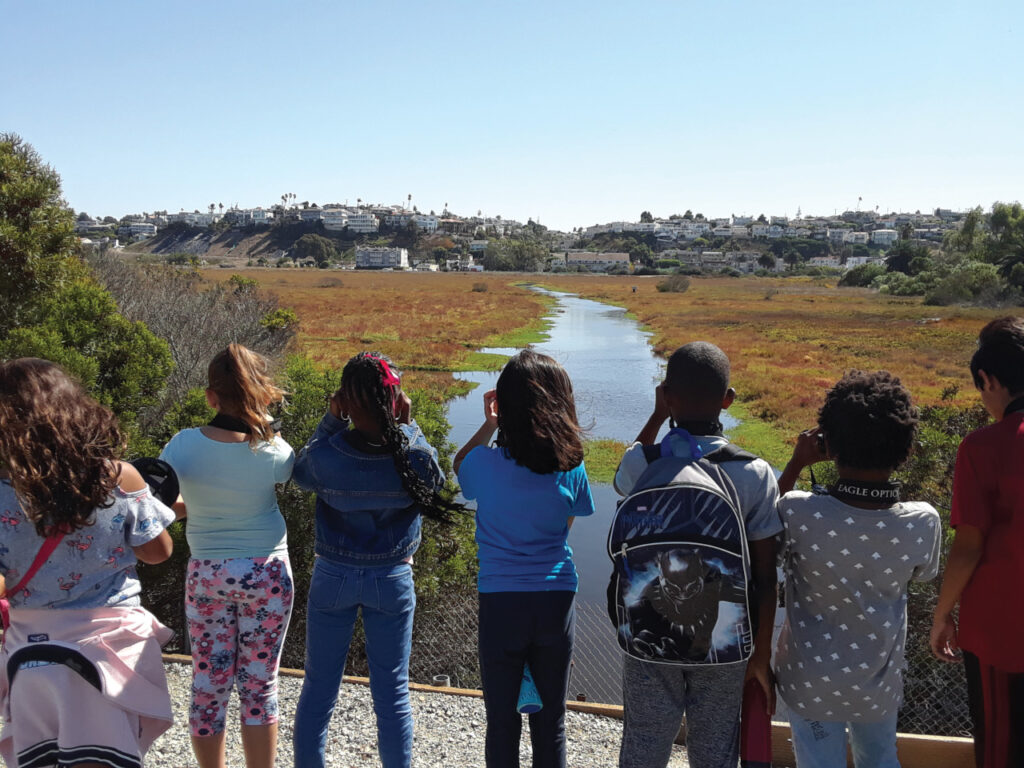
Students are often impressed with how much open space they see when they visit Ballona Wetlands. (Friends of Ballona Wetlands/Submitted)
By Morgan Owen
Before the Westside was a city, it was a coastal wetland rich with plant and animal diversity. Today, one remnant of this ancient ecosystem remains, the Ballona Wetlands. Carolyn Everhart, the manager of environmental education at Friends of Ballona Wetlands, teaches children about this once-great landscape that defined Santa Monica Bay.
Friends of Ballona Wetlands is one of many environmental groups on the lower Westside dedicated to preserving the Ballona Wetlands. One way they accomplish this is by offering the Explore Ballona program for schools across Los Angeles County to foster a sense of ownership and understanding about the wetlands.
On a typical Monday, Wednesday and Friday, Everhart can be seen escorting children throughout the wetlands, teaching them about the environment and the plants and animals that live there. Many groups are repeat visitors, returning each year to learn something new about Ballona.
Everhart explained that Friends of Ballona tailors their school tours to align with the science standards for each grade as mandated by the state of California. For second graders, Everhart will teach about plants and pollinators, while fourth graders focus on endangered animals.
It’s a great hands-on learning experience where students get to use binoculars, magnifying glasses and geoscience tools, Everhart says — and for many kids, this is one of the only times they get to be in a wide-open space.
“We get a lot of ‘woah’ (from the students) because they’re coming in from parts of the city where everything is cement. To come around this corner beyond the bushes and, suddenly, it’s all nature. It’s a really eye-opening moment. We get a lot of wonder and excitement,” Everhart says.
Explore Ballona doesn’t stop there. When Everhart isn’t in the wetlands leading field trips, she travels back to the schools for pre-trip and post-trip learning sessions. Pre-trip sessions usually prepare the kids for what they will experience. Sometimes, especially for the younger kids, she needs to reassure them that Ballona Wetlands is safe and free of lions, tigers and bears.
In the post-trip sessions, Everhart offers activities with the kids that solidify what they learned on their visit. For the second-grade classes, who learn about plants and pollinators on the trip, she will play a game where kids split up into groups — one pretending to be the plants and the other pretending to be the pollinators.
“What happens if we have kids walking off trail stepping on plants? How’s that going to affect the pollinators? (The students) start to think, ‘dude, this is not cool’ because they play as a pollinator,” Everhart says.
The concepts taught in these post-trip sessions become more advanced as students age. To tie in with the concepts of endangered species for fourth graders, Everhart teaches about habitat loss and how Ballona is only 5% of the historical habitat many of these species lived in.
While Friends of Ballona advocates for protecting the wetlands, Everhart says it’s not her job to teach the kids what she believes is right and wrong, simply presenting the facts.
“It’s really important for us to provide the information but not necessarily provide the ‘right’ answer. We might come to different conclusions, and that’s OK … Usually, after they’ve been out there, they are coming to conclusions that are in line with what the broader environmental field hopes for, but our job is to give them information and let them come to their own conclusions,” Everhart says.
In terms of their learning, Everhart says almost every grade level is receptive and excited to be taught about Ballona Wetlands. The challenge, instead, is the logistics of getting the kids to the wetlands.
Friends of Ballona offers transportation vouchers to schools to help pay for busing the kids to the ecological preserve. They also only ask for an honorarium payment of $5 per person but assure schools that an inability to pay will not impact their ability to schedule a trip.
Another difficulty is that Friends of Ballona has a limited number of trips they can schedule through Explore Ballona. Staff and time are both limitations they must contend with. The good news is that Explore Ballona isn’t the only educational program available to the public.
In addition to Explore Ballona, Friends of Ballona Wetlands also tries to schedule public weekly tours. Each tour has limited spaces and must be booked in advance. Once they know who is going on the trip, the educator leading the trip will create a lesson plan catered to those attending.
“It depends on who shows up,” says Alexis Elias, manager of communications and community engagement. “We get a lot of scouts that come out to our tours. If there’s a majority of students, (our docents) will carry it more like a student tour. Whereas if it’s more adults, they’ll go into more detail about complex things.”
The community tours are open to everyone interested in learning about Ballona Wetlands, and Elias and Everhart encourage those interested in learning about the environment to sign up, weather permitting.
For people in the community interested in doing more than just a tour, Friends of Ballona Wetlands also leads community habitat restoration tours. That program allows students, families, volunteers, and retirees to get dirty doing restoration work planting native species and removing invasive plants.
“I think the most important thing is the exposure of not only the students but (the adults) that come out to natural places. To give students the opportunity to explore (the wetlands) and have a little bit of wonder will hopefully ignite in them a desire to learn more about natural places,” Everhart says. “Hopefully one day they will want to care about it and maybe that day is today.”
Leave a Reply